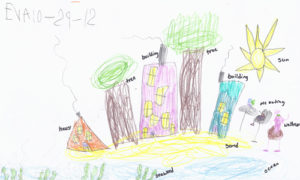1994 – Dr. Margot Conery-Clifford, faculty member in the Aquinas College School of Education begins working with the Aquinas Child Development Center staff to start incorporating principles of the Reggio Emilia Approach within the daily practice of the caregivers.
1995 – Courses are developed in the Aquinas College School of Education, Early Childhood Program, focusing on the principles, theories, and practice of the approach.
1998 – A group of parents, wanting an alternative to the traditional elementary school offerings in the city, forms an exploratory committee to research options for starting a Reggio-inspired elementary school in Grand Rapids.
1999 – Aquinas College leadership and faculty enter into a partnership and agreement with Grand Rapids Public Schools to have the district sponsor the charter agreement for the school.
- Harry Knopke, AQ President
- Patricia Newby, GRPS Superintendent
- James Garofolo, Dean, AQ School of Education
- Margot Conery-Clifford, Professor AQ School of Education
- Nkechy Ezeh, Professor AQ School of Education
1999 – The Aquinas Child Development Center moves to the former St. Adalbert School, leasing the space from the Diocese of Grand Rapids.
2000 – The school begins with 80 students in grades K-2. Susan Lukaart is hired as the school’s first Principal, and David Kelly, is hired as a faculty member at Aquinas College, and as part of this role, serves as the school Pedagogista part-time.
2001 – Third grade is added.
2002 – Fourth grade is added.
2002-2003: The idea of the Hive was created at GRCDC, it is inspired by, and based in theory on a place called Remida, in Italy. It is repository in which materials from businesses such as machinery parts, java jackets, buckets of buttons, and fabric are collected. The materials are organized by plastic, paper, metal, fabric and are beautifully arranged to invoke creativity, exploration and inspired work. The hive acts as a collection of goods that are yet another language for the children to use. A Natural Hive (sticks, plants, rocks, etc) is also introduced as a part of the larger Hive.
2003 – Fifth grade is added. The staff consists of 11 classroom teachers.
2007 – Leila Gandini, Liaison for the Reggio Emilia Program in the U.S., visits the GRCDC.
2008 – Principal Susan Lukaart retires and is replaced by Shel Hiscock.
2008-2009 –Standardized assessments reflect poor student scores. This signifies students’ difficulties with the Michigan Curriculum Framework standards and benchmarks. Staff and Administration work to align curriculum with the standards, creating a framework, scope and sequence to facilitate increased student achievement. Enrollment dropped at this time as a result. There did remain a core group of families committed to the success of the school, who offered their support through this period.
January 2009 – Shel Hiscock resigns after six months as principal.
March 2009 – David Hill is hired as third principal.
April 2010 – The GRCDC celebrates its 10th anniversary.
May 2010 – Doreen Bolhuis is hired as part-time Executive Director. The Board determined they needed the professional expertise and objectivity of an individual who could help organize and re-structure the school both culturally and financially.
June 2010 – David Hill and David Kelly both resign their positions.
August 2010 – Erin Melcher is hired a the fourth principal of the school. This was a pivotal and unsettling time. There were critical financial, academic and human resource issues facing the school at that time. Two paraprofessionals, a teacher, and the newly hired pedagogista resign before Thanksgiving of that year. Enrollement is at 180 students.
January 2011 – The Board of Directors initiates a capital campaign to renovate, expand, operate and increase programming in a new facility – the former Vandenberg Elementary of the southeast side of Grand Rapids. The project budget is $5.2 million dollars.
March 2011 – The GRCDC is awarded its first grant by the WK Kellogg Foundation. It is a $200,000 research grant to analyze, determine, and report on which aspects of the Reggio Emilia Approach, and school systems and programs are the most significant factors in the school’s success and which of those can be replicated in traditional schools.
June 2011 – The GRCDC purchases the former Vandenberg Elementary from GRPS for $490,000.
July 2011 – The GRCDC is awarded a $350,000 grant by Steelcase Foundation, $75,000 from the Sebastian Foundation and $25,000 by Grand Rapids Community Foundation.
August 2011 – The GRCDC engages in the clean-up, renovation and move to its new site at 409 Lafayette SE. The impetus behind this move was due to several factors. The first priority was the need for a fully accessible building. The new building had a fully functioning elevator and lift to provide access for all students, family members and visitors. The second need was ownership. Holding a mortgage on the facility provides the perception and reality of permanence which aids in increasing enrollment, stability, and fundraising efforts. In addition, the move to the previously vacant building was a applauded and supported by the neighbors and businesses surrounding the site.
September 2011 – The first school year at 409 Lafayette SE.
January 2012 – After two years without pedagogista (June 2010 to August 2012), the staff determined a pedagogista was necessary. Since resignation of the pedagogista shortly before Thanksgiving of 2010, the school was faced with a dilemma. The timing of her departure meant that a proper search and hire for a replacement would not be completed for many months. As a result, the principal proposed that the staff conduct an experiment in they act as pedagogistas for themselves and one another. The concept was based on the idea that each member had experience and agency that could provoke and push practice forward while maintaining the integrity of the Approach. The experiment was conducted, but in January of 2012, the staff determined a pedagogista was needed.
August 2012 – Sarah Cooper, previously a teacher at the school, was hired as Pedagogista. At the Grand Rapids Child Discovery Center, our current Pedagogista works twenty-five hours per week. Her duties include observing teachers in classrooms, collaborating with students on projects, collaborating with the Studio Coordinator to insure continuity between studio and classroom, keeps the Principal updated on projects, studies and issues in the various grade levels, acts a liaison between the staff and the Family Team, and above all, supporting the implementation of the Approach throughout the school. The pedagogista is viewed as a co-learner, co-constructor of knowledge, continually bringing about new questions, and pushing the Cycle of Inquiry through multiple and constant revolutions of thought, question and discovery.
August 2013 – For the first time in GRCDC history, there is a waiting list for students wanting to attend. Enrollment is capped at 240 students and there is a waiting list for certain ages due to having received 260 applications.





